|
Monday, January 21, 2008
Progress Notes
Louie Clarke Lawson (photo 01) was
one of Miller County's real "old timers". She was born in 1880 and lived in the
Tuscumbia area much of her life. For many years in the fifties and sixties she wrote the
"Real Rural Rustlers" news column for the Autogram-Sentinel newspaper.
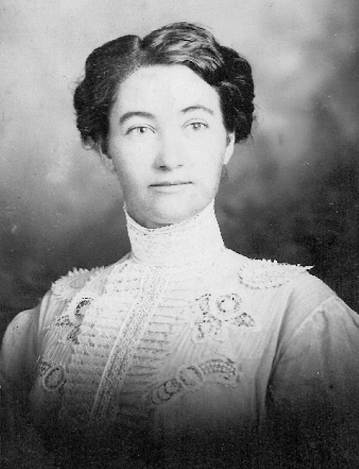
01 Louie Clarke Lawson
I knew her growing up as a boy in Tuscumbia as well as her husband, Claude Lawson, and
their son Toliver Lawson. Toliver married Helen Fogleman and they had one son named Bill.
They were neighbors living in the house next to mine for many years in Tuscumbia. I
remember Claude as being extra skilled at playing and winning pool games at Sweaney's, our
local pool hall, tavern, restaurant and general all round meeting place down by the river
in Tuscumbia (photo 02).
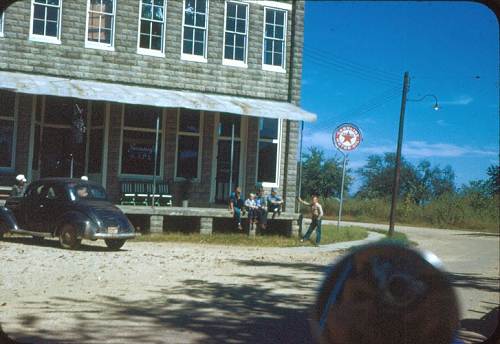
02 Sweaney's Cafe
Louie and Claude lived up the river road on a farm. Toliver was well known for many
things, one of them as being the jig dancing member of the Lake of the Ozarks Square Dance
Team which became nationally famous for awhile back in the early fifties. Louie was a
historian and wrote many historical articles for the paper. One of these is copied here in
which she discusses her early life as the granddaughter of James Skinner (photo 03), occupant of the infamous Skinner
Tomb located on Highway 52 between Tuscumbia and the 52/54 junction (photo 04).

03 James Skinner
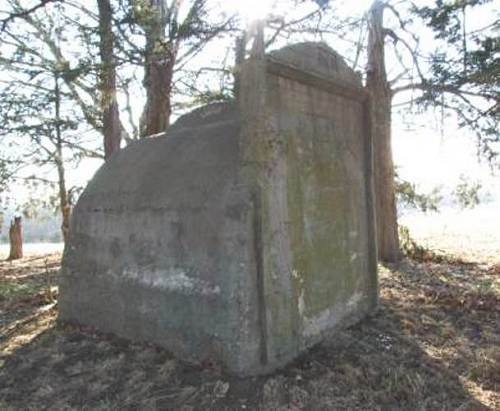
04 Skinner Tomb
You can read more about the Skinner Tomb itself in the very interesting article written
by Peggy Hake which is on our website at: http://www.millercountymuseum.org/articles/skinner.html
My Grandfather James Skinner (written approximately in 1960)
Louie Clarke Lawson
My grandfather James Skinner, was born in London, England.
When he was 7 years old he, his brother, Tom and mother and father set sail for the United
States to seek a new home. While crossing, his father died, and when they arrived in New
York, his mother found herself with two small children, no money and no way of supporting
herself. So she bound my grandfather out to some rich folks where he was a servant until
he was 21. He met my grandmother, Lucy Miriam Folsom in Schenectady, N. Y. Lucy was a
cousin of Mrs. Grover Cleveland who was also a Folsom. When he was 24 and she 14 they went
to Palmyra, Wis., and were married. Soon after, they came to Missouri, settling in Sedalia
just before the War. He was a carpenter by trade and built one of the first houses in
Sedalia; and my mother, Isabelle Skinner, I've been told was the first white child born
there. Two other children were born there but died.
He went into the mercantile business there, but was burned
out during the war. He was in the Army, and after the war he moved to Knob Noster where he
went into the saloon business for several years. His next move was to what is known as the
"old Skinner farm" in Miller County. No one knows how he located it, as there
was no way of communicating in those days, unless he saw it during one of his marches.
Here he homesteaded 600 acres of wilderness, built a large
log house with a large old fashioned fireplace, and a shed on the side of it. He brought a
horse, a cow and a team of oxen with him. These were housed in the shed. Here is where
Aunt Ellen, now Mrs. R. L. Smith of Kansas City, and Aunt Mary Vaughn, now Mrs. B. F.
Vaughn of Kingfisher, Oklahoma, and Lucy were born. Ellen and Mary are now living. Aunt
Ellen is nearly 94 and Aunt Mary will be 88 in January.
It is thought he must have brought a lot of money with him,
as he brought it in a beer keg. Besides his family he kept two or three men hired whom he
boarded in the old log house. After they moved he, with the help of his hired men,
commenced clearing and making rails
He never believed in doctors, but needed help at the birth of
their children so he gave Grandpa Folsom 100 acres to get him to come to Miller County
from the East. He built a large log house about where the John Heafey house is now, owned
by one of John's nieces. Grandpa Folsom, his wife and her mother moved there, and Mr.
Folsom's mother helped out with the birth of the children. Lucy died when quite small and
Grandpa, not wanting to take her to a strange place for burial, fenced off a plot for a
family cemetery. This is now known the Skinner Cemetery.
When Aunt Ellen was 7 years old, he started to build on the
hill. He first built a large basement, making his own brick and burning them. Here they
Iived for a few years.
The story goes that he got into an argument over a hog and
spent most of his ready cash. In a few years he built the big house over the basement
where it now stands. He had to haul all of his lumber from California, Mo. with an ox
team. Aunt Ellen says by the time she was 14, he with the help of two or three hired hands
had made rails and fenced the entire 600 acres. As they cleared they planted. He planted a
large orchard with all kinds of fruit, the first and largest in that part the country.
Each fall he shipped out carloads of hogs and cattle, fattening his hogs on acorns. She
says, looking back now, she doesn't know how he did so much in such a short time.
He wouldn't have anything do with the banks and wouldn't
accept anything but gold when he shipped his cattle and hogs so he had a lot of gold
around the house at all times, and I never knew of him being robbed. Aunt Ellen said that
when she was 14, he and grandmother made their first trip back East, getting an old lady
to stay with the children. He had a lot of gold, mostly $20 gold pieces, and before he
left, he stacked it in the bottom of her trunk, telling her not to let anyone know where
it was. This she did as told.
When they moved to the 600 acres, there had never been a
school. They both being educated folk, wanted their children to be too, so they commenced
talking of a school.
He donated land for a school house. The folks there weren't
interested in a school, and didn't see any need of one, so he had to win them over. He,
being a carpenter, built the Skinner schoolhouse (photo 05 and photo 06).
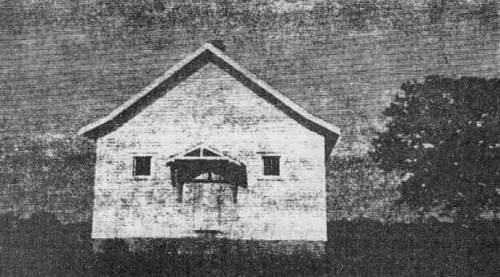
05 Skinner School - Before Renovation
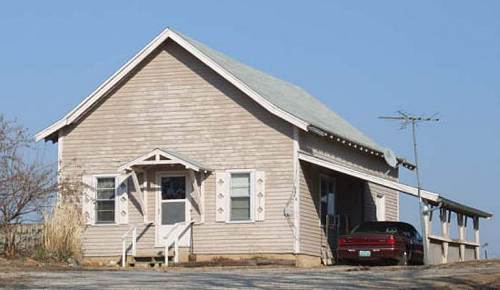
06 Skinner School - Now used as home
Then when it was finished, there was no water, only what the
children carried from a spring under the hill about a mile away and sometimes when they
got it there, it wasn't fit to drink. His children never drank the water as they would go
across the pasture home for their lunches. He finally got some of the farmers interested
in digging a well. They dug a large hole and grandfather cemented it, thus they had a
cistern. He then made filters to catch the water.
(Note: you can read more about the Skinner School on our website at: http://www.millercountymuseum.org/schools/MCSS029.html)
As I have said, he had planted a large orchard. When it began
to bear fruit, he would take it to Tuscumbia. He and his daughter, Isabelle, my mother,
who almost always accompanied him, were familiar figures as they would go up and down the
street selling apples, cider or other produce of which he had an abundance.
I have been told many times by my grandmother that he and my
mother were both wonderful dancers, and would put on exhibition dances to attract folk to
their wares. I think that must have been how she met my father, Charles H. Clarke (photo 07), and
married him. It was one Englishman meeting another.
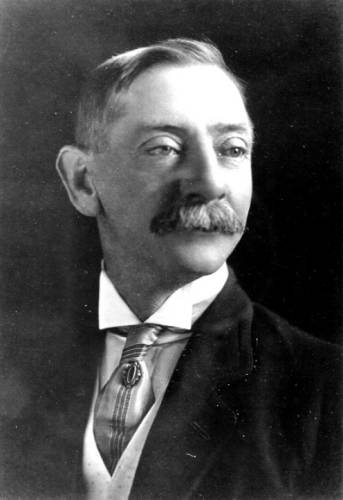
07 Charles Clarke
When my mother died in 1885, she was laid to rest beside an
infant son, James, in the Skinner cemetery, and my sister, Lillie and I were taken by my
grandparents. They had a little daughter, Hattie; my sister was age 3, and I was 5.
Looking back, I still wonder how she managed us with all the work she had to do and no
modern conveniences to help her.
I learned to milk that first winter. They had a low squattie
cow they called "Old Bench," and Grandfather made me a low stool to sit on. We
were all given light work to do as soon as we were big enough to do it and it was a good
thing, as when we weren't busy, we were out and gone. Then the hunt was on; Grandma, Aunt
Ellen, Aunt Mary, and sometimes Uncle Jim and the hired hands would take part in the
chase. My father always said one girl is a girl; two girls are half a girl, and three
girls are no girl at all, which proved true there. My grandfather wasn't a cruel man but
he worked hard and all around him did their share.
We three pulled weeds, planted corn, thinned corn, and I have
even stood in the field to scare the crows away. The crows were so bad that they would
take a field of young corn in no time.
All the supplies were bought in large quantities: barrels of
sugar, salt, flour, etc., and everything was paid for in gold.
When they started to remodel the house, I remember they had
several arguments about where they would put the front door and gate. Grandmother wanted
to put it facing the road, and grandfather, to the back. Grandma came out second best, and
the door and gate were at the back.
He made French windows in the room facing the road which was
the parlor, but as long as he owned the farm there was no porch to get out on, until it
was bought by Mr. Heafey, father of John and Joe Heafey. Grandma always called it her
backward house (photo 08).
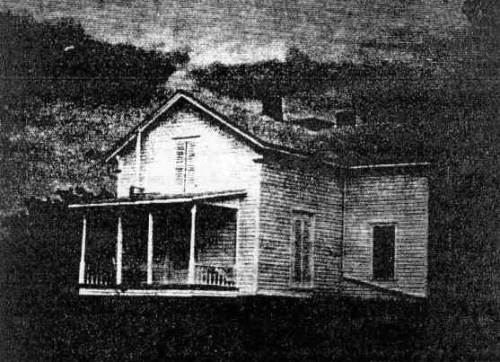
08 House that Jim Skinner built
My grandparents were both very fond of cedar trees, and had
many kinds in the large yard. In fact, before he left the farm, he made their caskets out
of cedar from the farm and when they died the caskets were so hard they couldn't drive a
nail in them, but some way they got them covered and handles on them and both were laid to
rest in them.
He was a shrewd trader and if you didn't watch him, you'd
lose your hat. After they moved to Eldon, he built his own vault and people passing by
would ask, "Mr. Skinner, doesn't it make you feel badly to be building your own
tomb?"
He'd throw his head back and laugh and say, "No, I could
just lie down here and go to sleep."
There are four generations buried in that little cemetery.
The young fellows who had been out on dates used to call out
as they passed, "Hello, Old Skinner, what are you doing in there?" Joe Heafey
thought he'd put a scare into them one night and hid behind the tomb and when they came
along, and called out to "Old Skinner," he answered them. It is said some of the
boys came nearly running their horses to death in getting away. After that they let
"Old Skinner" rest..
After my grandparents died, the tomb was never sealed, as my
Uncle Jim wouldn't let them. Anyone could go in when they wished and did. Some folks got
to going in and having drinking parties, so Joe Heafey wrote my Aunt Hattie Duncan about
it and they came back and sealed it, so at last, James and Lucy Skinner were at rest.
So that is the story of the Skinner farm as told by Louie Clarke Lawson, granddaughter
of James Skinner. You can read more about the general area of "Flatwoods" where
the Skinner farm (now known as the Heafy farm) is located at the following location on our
website: http://www.millercountymuseum.org/communities/flatwoods.html
I will have some more of Louie's pieces uploaded to this site in the near future. One
series, particularly interesting, is her history of Tuscumbia as she recalled it herself.
She lived during the time the steamboats were running up and down the river and when
Tuscumbia was still the seat of commerce in Miller County.
I am indebted to Michael Wieneman, originally of Eldon, who supplied me with the photos
of Louie Clarke Lawson and her father Charles Clarke. Michael has an extensive collection
of old photos having to do with Miller County and he has helped us in the past. It is much
appreciated. Mike also sent me the obituary of Mrs. Lawson which for completeness is
presented below:
LOUIE CLARKE LAWSON
Birth: Nov. 17, 1880 Death: Oct. 9, 1969
Obituary: Miller County Autogram-Sentinel, October 1969
Mrs. Louie Clarke Lawson, a member of one of Miller County's
pioneer families, died early today (Thursday, Oct. 9, 1969) at her home in Tuscumbia. She
was 88 years of age. For many years Mrs. Lawson served as the Autogram-Sentinel's Real
Rural Rustlers' correspondent and contributed many feature stories about history of the
community.
She was born Nov. 17, 1880, the daughter of Charles H. and
Isabelle (Skinner) Clarke. Her grandfather, James Skinner, a native of England, had
homesteaded 600 acres in Miller County, and donated the land and built the schoolhouse for
Skinner School, formerly in session on Hwy. 52 between Tuscumbia and Eldon.
On April 3, 1902 she was married to James Claude Lawson. They
lived in Kansas City from 1924 to 1937, but most of their married life was spent in Miller
County. They lived on an Osage River farm above Tuscumbia which had been in the Lawson
family 80 years.
Mr. Lawson died Nov. 19, 1961. Mrs. Lawson was also preceded
in death by a son, Tolliver Clarke Lawson, on June 27, 1965.
Survivors include four daughters: Mrs. Wilma Harbison of
Tuscumbia, Mrs. Lillian Miller of Kansas City, Kan., and Mrs. Maude Teegarden and Mrs. Jo
Louise Pfeifer of Kansas City, Mo.
Funeral services under the direction of Philips Funeral Home
of Eldon were incomplete at press time.
Burial: Tuscumbia Cemetery Tuscumbia Miller County Missouri,
USA
I am on vacation for a couple of weeks but will continue uploading to this site a few
things of interest each week.
| 


